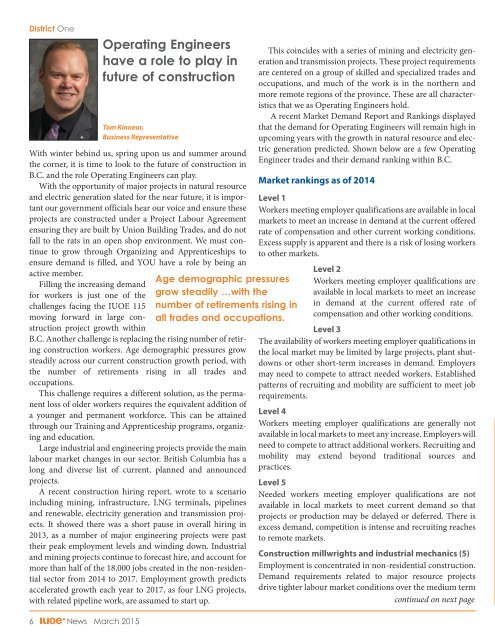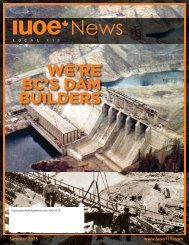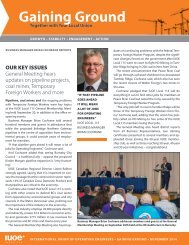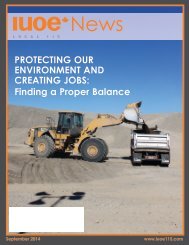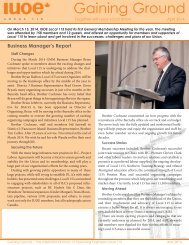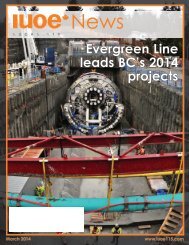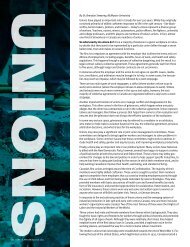IUOE News February 2015
You also want an ePaper? Increase the reach of your titles
YUMPU automatically turns print PDFs into web optimized ePapers that Google loves.
District One<br />
With winter behind us, spring upon us and summer around<br />
the corner, it is time to look to the future of construction in<br />
B.C. and the role Operating Engineers can play.<br />
With the opportunity of major projects in natural resource<br />
and electric generation slated for the near future, it is important<br />
our government officials hear our voice and ensure these<br />
projects are constructed under a Project Labour Agreement<br />
ensuring they are built by Union Building Trades, and do not<br />
fall to the rats in an open shop environment. We must continue<br />
to grow through Organizing and Apprenticeships to<br />
ensure demand is filled, and YOU have a role by being an<br />
active member.<br />
Filling the increasing demand<br />
for workers is just one of the<br />
challenges facing the <strong>IUOE</strong> 115<br />
moving forward in large construction<br />
project growth within<br />
B.C. Another challenge is replacing the rising number of retiring<br />
construction workers. Age demographic pressures grow<br />
steadily across our current construction growth period, with<br />
the number of retirements rising in all trades and<br />
occupations.<br />
This challenge requires a different solution, as the permanent<br />
loss of older workers requires the equivalent addition of<br />
a younger and permanent workforce. This can be attained<br />
through our Training and Apprenticeship programs, organizing<br />
and education.<br />
Large industrial and engineering projects provide the main<br />
labour market changes in our sector. British Columbia has a<br />
long and diverse list of current, planned and announced<br />
projects.<br />
A recent construction hiring report, wrote to a scenario<br />
including mining, infrastructure, LNG terminals, pipelines<br />
and renewable, electricity generation and transmission projects.<br />
It showed there was a short pause in overall hiring in<br />
2013, as a number of major engineering projects were past<br />
their peak employment levels and winding down. Industrial<br />
and mining projects continue to forecast hire, and account for<br />
more than half of the 18,000 jobs created in the non-residential<br />
sector from 2014 to 2017. Employment growth predicts<br />
accelerated growth each year to 2017, as four LNG projects,<br />
with related pipeline work, are assumed to start up.<br />
6 <strong>News</strong> March <strong>2015</strong><br />
Operating Engineers<br />
have a role to play in<br />
future of construction<br />
Tom Kinnear,<br />
Business Representative<br />
Age demographic pressures<br />
grow steadily …with the<br />
number of retirements rising in<br />
all trades and occupations.<br />
This coincides with a series of mining and electricity generation<br />
and transmission projects. These project requirements<br />
are centered on a group of skilled and specialized trades and<br />
occupations, and much of the work is in the northern and<br />
more remote regions of the province. These are all characteristics<br />
that we as Operating Engineers hold.<br />
A recent Market Demand Report and Rankings displayed<br />
that the demand for Operating Engineers will remain high in<br />
upcoming years with the growth in natural resource and electric<br />
generation predicted. Shown below are a few Operating<br />
Engineer trades and their demand ranking within B.C.<br />
Market rankings as of 2014<br />
Level 1<br />
Workers meeting employer qualifications are available in local<br />
markets to meet an increase in demand at the current offered<br />
rate of compensation and other current working conditions.<br />
Excess supply is apparent and there is a risk of losing workers<br />
to other markets.<br />
Level 2<br />
Workers meeting employer qualifications are<br />
available in local markets to meet an increase<br />
in demand at the current offered rate of<br />
compensation and other working conditions.<br />
Level 3<br />
The availability of workers meeting employer qualifications in<br />
the local market may be limited by large projects, plant shutdowns<br />
or other short-term increases in demand. Employers<br />
may need to compete to attract needed workers. Established<br />
patterns of recruiting and mobility are sufficient to meet job<br />
requirements.<br />
Level 4<br />
Workers meeting employer qualifications are generally not<br />
available in local markets to meet any increase. Employers will<br />
need to compete to attract additional workers. Recruiting and<br />
mobility may extend beyond traditional sources and<br />
practices.<br />
Level 5<br />
Needed workers meeting employer qualifications are not<br />
available in local markets to meet current demand so that<br />
projects or production may be delayed or deferred. There is<br />
excess demand, competition is intense and recruiting reaches<br />
to remote markets.<br />
Construction millwrights and industrial mechanics (5)<br />
Employment is concentrated in non-residential construction.<br />
Demand requirements related to major resource projects<br />
drive tighter labour market conditions over the medium term<br />
continued on next page


